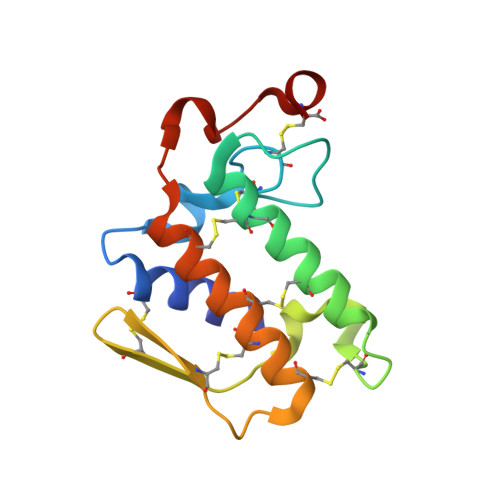Anti-inflammatory property of n-hexadecanoic acid: Structural evidence and Kinetic assessment.
Aparna, V., Dileep, K.V., Mandal, P.K., Karthe, P., Sadasivan, C., Haridas, M.(2012) Chem Biol Drug Des
- PubMed: 22642495
- DOI: https://doi.org/10.1111/j.1747-0285.2012.01418.x
- Primary Citation of Related Structures:
3QLM - PubMed Abstract:
Ester bond hydrolysis of membrane phospholipids by Phospholipase A(2) and consequent release of fatty acids are the initiating steps of inflammation. It is proposed in this study that the inhibition of phospholipase A(2) is one of the ways to control inflammation. Investigations are carried out to identify the mode of inhibition of phospholipase A(2) by the n-hexadecanoic acid. It may help in designing of specific inhibitors of phospholipase A(2) as anti-inflammatory agents. The enzyme kinetics study proved that n-hexadecanoic acid inhibits phospholipase A(2) in a competitive manner. It was identified from the crystal structure at 2.5 Å resolution that the position of n-hexadecanoic acid is in the active site of the phospholipase A(2). The binding constant and binding energy have also been calculated using Isothermal Titration Calorimetry. Also, the binding energy of n-hexadecanoic acid to phospholipase A(2) was calculated by in silico method and compared with known inhibitors. It may be concluded from the structural and kinetics studies that the fatty acid, n-hexadecanoic acid, is an inhibitor of phospholipase A(2), hence, an anti-inflammatory compound. The inferences from the present study validate the rigorous use of medicated oils rich in n-hexadecanoic acid for the treatment of rheumatic symptoms in the traditional medical system of India, Ayurveda.
- Department of Biotechnology & Microbiology, Kannur University, Thalassery Campus, Palayad, India.
Organizational Affiliation:


















